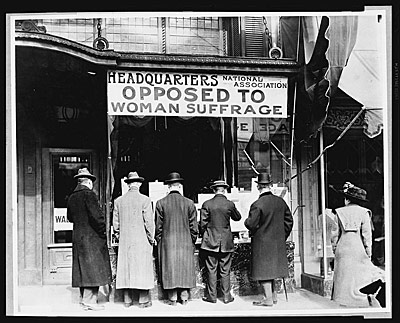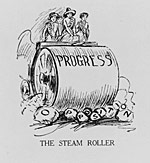
Unit 5: Crisis and Change
Lesson D: Postwar Anxiety, Creativity, and Change
Activity 8: Women's Suffrage Historical Opposition
As of the end of 2010, women had partial or no suffrage in five of the world’s countries. These include Brunei, Lebanon, Saudi Arabia, the United Arab Emirates, and Vatican City/The Holy See. Three of these limit both men and women in their rights to vote. Lebanon allows women to vote, but requires proof of elementary education and does not make voting compulsory for women, as it is for men. Saudi Arabia is the only country in the world with no suffrage for women.
Women's suffrage may be a nearly universal reality now, but, as the women's suffrage movement was gaining popularity in the United States (and elsewhere) at the beginning of the 20th century, suffragists were subject to arrest and spending time in jail. Public opinion was not entirely in favor of this major change. This political cartoon shows a counter-view to suffrage in the United States. The four women suffragists depicted are shown riding a steamroller and crushing rocks labeled the "opposition."
The following image shows action taken by some in the United States to found an organization opposed to women’s suffrage. The anti-suffrage movement was well-organized and well-funded. This movement argued that most women really did not want the right to vote and may not actually be qualified to vote anyway.

Men Looking in the Window of the National Anti-Suffrage Association Headquarters [2]
Directions: Read the following humorous response to anti-suffrage written by Alice Duer Miller, a poet, satirist, and writer from New York City.
Why We Don't Want Men to Vote
- Because man's place is in the army.
- Because no man really wants to settle any question otherwise than by fighting about it.
- Because if men should adopt peaceable methods, women will no longer look up to them.
- Because men will lose their charm if they step out of their natural sphere and interest themselves in other matters than feats of arms, uniforms, and drums.
- Because men are too emotional to vote. Their conduct at baseball games and political conventions shows this, while their innate tendency to appeal to force renders them unfit for government.
Classroom Activity - Women's Suffrage
![]() Discussion
Discussion
Directions: Prepare a response to the discussion questions below. Follow your teacher's directions to participate in your class discussion.
- Are the claims as accurate and solid as those presented by the anti-suffragists?
- How do Alice Duer Miller's words reflect the attitudes about "women" and their relationship to society that presented the historical challenge to women's suffrage?
![]() Select the link to review the Discussion Scoring Tool (pdf).
Select the link to review the Discussion Scoring Tool (pdf).
Page Notes:
[1] Source: This work from http://en.wikipedia.org/wiki/File:US_SuffrageSteamrollerCartoon.png is in the public domain in the United States because it was registered with the U.S. Copyrights Office or published before January 1, 1923.
[2] Source: This image from http://memory.loc.gov/cgi-bin/query/r?ammem/suffrg:@FIELD%28NUMBER%283a26270%29%29 is from the Library of Congress. The Library of Congress has exhaustively researched the contents of this collection to ascertain any possible legal rights embodied in the materials. Items included here with the permission of rights holders are listed below. Many of the items in this collection are in the public domain, that is, not subject to copyright protection such as the works of employees of the federal government of the United States.



